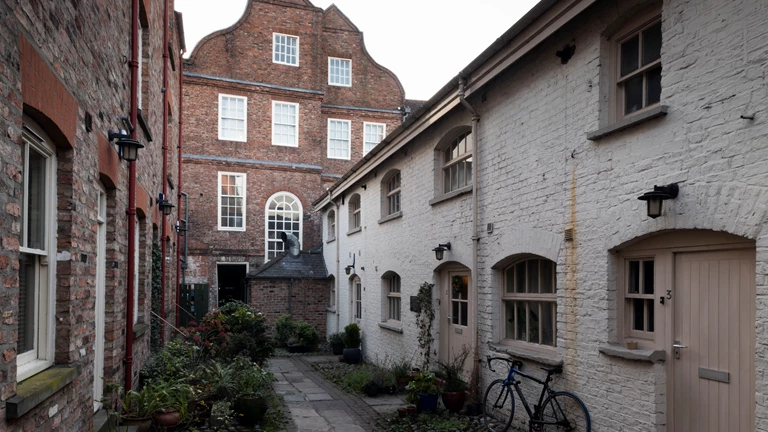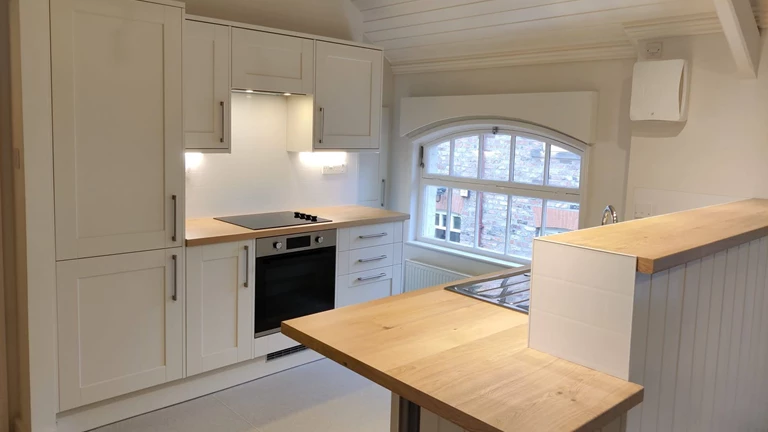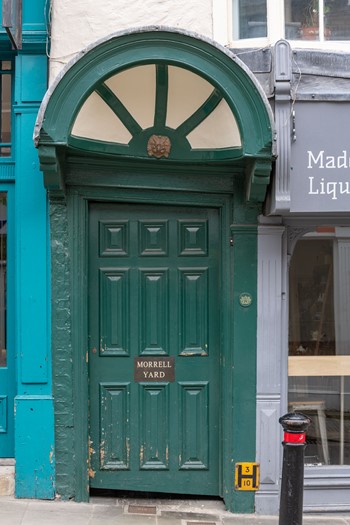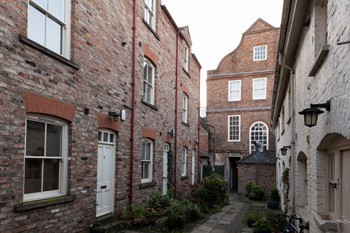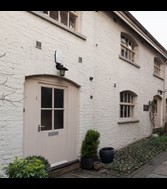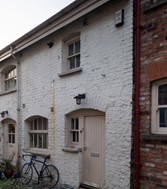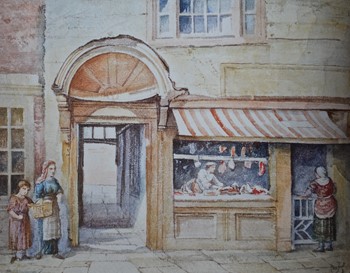Morrell Yard
Hidden behind a lion’s mask – a sought after complex of city centre homes created around a medieval well.
Morrell Yard is accessed off Fossgate. Crossing the river Foss and previously known as the ‘street of the Fishmongers’, Fossgate was home to many different trades and residents in this ancient area of York.
Fossgate formed part of the Roman road approaching York from the south, the Via Principalis, which ended at the southern entrance to the Roman fortress in what is now King’s Square. A high status route during the Roman occupation, later Fossgate was the main drover’s route to the bustling market on Pavement, where livestock was sold to the many butchers plying their trade nearby.
The pedestrian entrance to Morrell Yard is found between no. 13/14 and no. 15/16 Fossgate and accessed through an impressive doorway and ancient passageway or ‘ginnel’. Early maps suggest it connected to the site of the Carmelite Friary (demolished in 1538 ) and to a quay on the banks of the river Foss.
The passageway sits below a flying freehold (this describes part of a property that is built over the top of land which does not belong to it) of no. 15/16: a late medieval, half-timbered and jettied building still rendered at first and second floor level in its original stucco.
The shop next to the entrance on the ground floor has had a range of uses over time, but from 1850-1930 it was used as a butchers shop and captured in a watercolour study, painted in around 1900 by J W Knowles.
Knowles also features the handsome moulded doorway with an apsidal, or semi-circular, shell-hood supported on shaped console brackets. The ribbing inside the shell radiates from a small but ferocious looking lion mask, perhaps put there as a warning or a challenge those who enter below.
The flamboyant hood above the door, whilst not as practical as a porch, was a popular feature of buildings in the late 17th and early 18th centuries. Sadly, however, this example seems to be the only original one of its kind to survive in York. One other version, designed by the Victorian architect Walter Penty, was added to the front of the Old Grey Mare pub in Clifton in about 1890.
Those braving the intimidating stare of the lion above the Fossgate doorway can access Morrell Yard through a modern nine-panel door set within the ancient wooden frame that has clearly ‘eased’ overtime as the building has settled.
Inside, the Yard has a medieval well, said to be some 16 metres deep, not yet excavated, surrounded by a range of residential accommodation. Please do note that Morrell Yard is home to 10 private residents and therefore not suitable for tours.
When the Trust acquired the land and buildings, Morrell Yard, as it was later named, was formed by a hotchpotch of buildings differing in size, age and infirmity, including a former cabinet-makers workshop, three cottages in need of demolition and land from the Macdonald family next door. In 1998 the Trust decided to create a complex of 10 homes.
Standing in the yard and looking back towards the street, you can see an imposing brick elevation with stepped and shaped gables, dating from around 1700 this shows that, at some stage, no. 13/14 and no. 15/16 Fossgate were one building. As previously mentioned, the pedestrian passageway to Morrell Yard sits underneath the street facing property, whilst most of the brick extension seen in the Yard, with its arched window lighting an internal staircase, wraps around the rear of next door.
Completed in 1999, the residential complex is named in honour of the two brothers, Dr John Bowes Morrell and Cuthbert Morrell who founded Ings Property Company, which went on to become York Conservation Trust. The name also celebrates the fact their descendants continue as Trustees of the Trust today.
A short walk to the centre, with its sheltered location and the emergence of Fossgate as a popular destination for independent shops, bars and cafés, today Morrell Yard is a highly desirable place to live in the heart of York.
Discover more about Morrell Yard
Morrell Yard
Fossgate
York
YO1 9TW

